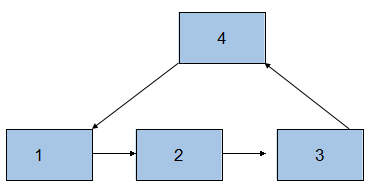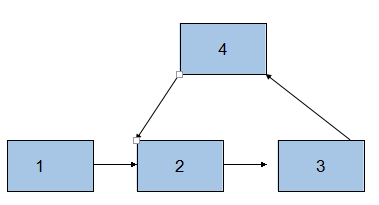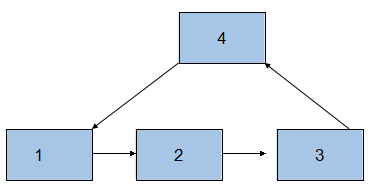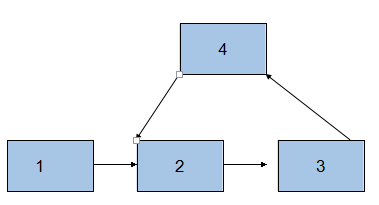链表面试题Java实现【重要】
【声明】
欢迎转载,但请保留文章原始出处→_→
生命壹号: http://www.cnblogs.com/smyhvae/
文章来源: http://www.cnblogs.com/smyhvae/p/4782595.html
联系方式:smyhvae@163.com
【正文】
这份笔记整理了整整一个星期,每一行代码都是自己默写完成,并测试运行成功,同时也回顾了一下《剑指offer》这本书中和链表有关的讲解,希望对笔试和面试有所帮助。OMG!
本文包含链表的以下内容:
1、单链表的创建和遍历
2、求单链表中节点的个数
3、查找单链表中的倒数第k个结点(剑指offer,题15)
4、查找单链表中的中间结点
5、 合并两个有序的单链表 ,合并之后的链表依然有序【出现频率高】(剑指offer,题17)
6、 单链表的反转 【出现频率最高】(剑指offer,题16)
7、从尾到头打印单链表(剑指offer,题5)
8、判断单链表是否有环
9、取出有环链表中,环的长度
10、单链表中,取出环的起始点(剑指offer,题56)。本题需利用上面的第8题和第9题。
11、判断两个单链表相交的第一个交点(剑指offer,题37)
此外,《剑指offer》中还有如下和链表相关的题目暂时还没有收录:(以后再收录)
剑指offer,题13:在O(1)时间删除链表结点
剑指offer,题26:复杂链表的复制
剑指offer,题45:圆圈中最后剩下的数字
剑指offer,题57:链表中环的入口结点
1、单链表的创建和遍历:
1 public class LinkList { 2 public Node head; 3 public Node current; 4 5 //方法:向链表中添加数据 6 public void add(int data) { 7 //判断链表为空的时候 8 if (head == null) {//如果头结点为空,说明这个链表还没有创建,那就把新的结点赋给头结点 9 head = new Node(data); 10 current = head; 11 } else { 12 //创建新的结点,放在当前节点的后面(把新的结点合链表进行关联) 13 current.next = new Node(data); 14 //把链表的当前索引向后移动一位 15 current = current.next; //此步操作完成之后,current结点指向新添加的那个结点 16 } 17 } 18 19 //方法:遍历链表(打印输出链表。方法的参数表示从节点node开始进行遍历 20 public void print(Node node) { 21 if (node == null) { 22 return; 23 } 24 25 current = node; 26 while (current != null) { 27 System.out.println(current.data); 28 current = current.next; 29 } 30 } 31 32 33 class Node { 34 //注:此处的两个成员变量权限不能为private,因为private的权限是仅对本类访问。 35 int data; //数据域 36 Node next;//指针域 37 38 public Node(int data) { 39 this.data = data; 40 } 41 } 42 43 44 public static void main(String[] args) { 45 LinkList list = new LinkList(); 46 //向LinkList中添加数据 47 for (int i = 0; i < 10; i++) { 48 list.add(i); 49 } 50 51 list.print(list.head);// 从head节点开始遍历输出 52 } 53 54 }
上方代码中,这里面的Node节点采用的是内部类来表示(33行)。 使用内部类的最大好处是可以和外部类进行私有操作的互相访问 。
注:内部类访问的特点是:内部类可以直接访问外部类的成员,包括私有;外部类要访问内部类的成员,必须先创建对象。
为了方便添加和遍历的操作,在LinkList类中添加一个成员变量current,用来表示当前节点的索引(03行)。
这里面的遍历链表的方法(20行)中,参数node表示从node节点开始遍历,不一定要从head节点遍历。
2、求单链表中节点的个数:
注意检查链表是否为空。时间复杂度为O(n)。这个比较简单。
核心代码:
1 //方法:获取单链表的长度 2 public int getLength(Node head) { 3 if (head == null) { 4 return 0; 5 } 6 7 int length = 0; 8 Node current = head; 9 while (current != null) { 10 length++; 11 current = current.next; 12 } 13 14 return length; 15 }
3、查找单链表中的倒数第k个结点:
3.1 普通思路:
先将整个链表从头到尾遍历一次,计算出链表的长度size,得到链表的长度之后,就好办了,直接输出第(size-k)个节点就可以了(注意链表为空,k为0,k为1,k大于链表中节点个数时的情况
)。时间复杂度为O(n),大概思路如下:
1 public int findLastNode(int index) { //index代表的是倒数第index的那个结点 2 3 //第一次遍历,得到链表的长度size 4 if (head == null) { 5 return -1; 6 } 7 8 current = head; 9 while (current != null) { 10 size++; 11 current = current.next; 12 } 13 14 //第二次遍历,输出倒数第index个结点的数据 15 current = head; 16 for (int i = 0; i < size - index; i++) { 17 current = current.next; 18 } 19 20 return current.data; 21 }
如果面试官不允许你遍历链表的长度,该怎么做呢?接下来就是。
3.2 改进思路:(这种思路在其他题目中也有应用)
这里需要声明 两个指针 :即两个结点型的变量first和second,首先让first和second都指向第一个结点,然后让second结点往后挪k-1个位置,此时first和second就间隔了k-1个位置,然后整体向后移动这两个节点, 直到second节点走到最后一个结点的时候,此时first节点所指向的位置就是倒数第k个节点的位置 。时间复杂度为O(n)
代码实现:(初版)
1 public Node findLastNode(Node head, int index) { 2 3 if (node == null) { 4 return null; 5 } 6 7 Node first = head; 8 Node second = head; 9 10 //让second结点往后挪index个位置 11 for (int i = 0; i < index; i++) { 12 second = second.next; 13 } 14 15 //让first和second结点整体向后移动,直到second结点为Null 16 while (second != null) { 17 first = first.next; 18 second = second.next; 19 } 20 21 //当second结点为空的时候,此时first指向的结点就是我们要找的结点 22 return first; 23 }
代码实现:(最终版)(考虑k大于链表中结点个数时的情况时,抛出异常 )
上面的代码中,看似已经实现了功能,其实还不够健壮:
要注意k等于0的情况;
如果k大于链表中节点个数时,就会报空指针异常,所以这里需要做一下判断。
核心代码如下:
1 public Node findLastNode(Node head, int k) { 2 if (k == 0 || head == null) { 3 return null; 4 } 5 6 Node first = head; 7 Node second = head; 8 9 //让second结点往后挪k-1个位置 10 for (int i = 0; i < k - 1; i++) { 11 System.out.println("i的值是" + i); 12 second = second.next; 13 if (second == null) { //说明k的值已经大于链表的长度了 14 //throw new NullPointerException("链表的长度小于" + k); //我们自己抛出异常,给用户以提示 15 return null; 16 } 17 } 18 19 //让first和second结点整体向后移动,直到second走到最后一个结点 20 while (second.next != null) { 21 first = first.next; 22 second = second.next; 23 } 24 25 //当second结点走到最后一个节点的时候,此时first指向的结点就是我们要找的结点 26 return first; 27 }
4、查找单链表中的中间结点:
同样,面试官不允许你算出链表的长度,该怎么做呢?
思路:
和上面的第2节一样,也是设置两个指针first和second,只不过这里是,两个指针同时向前走,second指针每次走两步,first指针每次走一步, 直到second 指针走到最后一个结点时,此时first指针所指的结点就是中间结点 。注意链表为空,链表结点个数为1和2的情况。时间复杂度为O(n)。
代码实现:
1 //方法:查找链表的中间结点 2 public Node findMidNode(Node head) { 3 4 if (head == null) { 5 return null; 6 } 7 8 Node first = head; 9 Node second = head; 10 //每次移动时,让second结点移动两位,first结点移动一位 11 while (second != null && second.next != null) { 12 first = first.next; 13 second = second.next.next; 14 } 15 16 //直到second结点移动到null时,此时first指针指向的位置就是中间结点的位置 17 return first; 18 }
上方代码中,当n为偶数时,得到的中间结点是第n/2 + 1个结点。比如链表有6个节点时,得到的是第4个节点。
5、合并两个有序的单链表,合并之后的链表依然有序:
这道题经常被各公司考察。
例如:
链表1:
1->2->3->4
链表2:
2->3->4->5
合并后:
1->2->2->3->3->4->4->5
解题思路:
挨着比较链表1和链表2。
这个类似于归并排序。尤其要注意两个链表都为空、和其中一个为空的情况。只需要O (1) 的空间。时间复杂度为O (max(len1,len2))
代码实现:
1 //两个参数代表的是两个链表的头结点 2 public Node mergeLinkList(Node head1, Node head2) { 3 4 if (head1 == null && head2 == null) { //如果两个链表都为空 5 return null; 6 } 7 if (head1 == null) { 8 return head2; 9 } 10 if (head2 == null) { 11 return head1; 12 } 13 14 Node head; //新链表的头结点 15 Node current; //current结点指向新链表 16 17 // 一开始,我们让current结点指向head1和head2中较小的数据,得到head结点 18 if (head1.data < head2.data) { 19 head = head1; 20 current = head1; 21 head1 = head1.next; 22 } else { 23 head = head2; 24 current = head2; 25 head2 = head2.next; 26 } 27 28 while (head1 != null && head2 != null) { 29 if (head1.data < head2.data) { 30 current.next = head1; //新链表中,current指针的下一个结点对应较小的那个数据 31 current = current.next; //current指针下移 32 head1 = head1.next; 33 } else { 34 current.next = head2; 35 current = current.next; 36 head2 = head2.next; 37 } 38 } 39 40 //合并剩余的元素 41 if (head1 != null) { //说明链表2遍历完了,是空的 42 current.next = head1; 43 } 44 45 if (head2 != null) { //说明链表1遍历完了,是空的 46 current.next = head2; 47 } 48 49 return head; 50 }
代码测试:
1 public static void main(String[] args) { 2 LinkList list1 = new LinkList(); 3 LinkList list2 = new LinkList(); 4 //向LinkList中添加数据 5 for (int i = 0; i < 4; i++) { 6 list1.add(i); 7 } 8 9 for (int i = 3; i < 8; i++) { 10 list2.add(i); 11 } 12 13 LinkList list3 = new LinkList(); 14 list3.head = list3.mergeLinkList(list1.head, list2.head); //将list1和list2合并,存放到list3中 15 16 list3.print(list3.head);// 从head节点开始遍历输出 17 }
上方代码中用到的add方法和print方法和第1小节中是一致的。
运行效果:

注:《剑指offer》中是用递归解决的,感觉有点难理解。
6、 单链表的反转 :【出现频率最高】
例如链表:
1->2->3->4
反转之后:
4->2->2->1
思路:
从头到尾遍历原链表,每遍历一个结点,将其摘下放在新链表的最前端。注意链表为空和只有一个结点的情况。时间复杂度为O(n)
方法1:(遍历)
1 //方法:链表的反转 2 public Node reverseList(Node head) { 3 4 //如果链表为空或者只有一个节点,无需反转,直接返回原链表的头结点 5 if (head == null || head.next == null) { 6 return head; 7 } 8 9 Node current = head; 10 Node next = null; //定义当前结点的下一个结点 11 Node reverseHead = null; //反转后新链表的表头 12 13 while (current != null) { 14 next = current.next; //暂时保存住当前结点的下一个结点,因为下一次要用 15 16 current.next = reverseHead; //将current的下一个结点指向新链表的头结点 17 reverseHead = current; 18 19 current = next; // 操作结束后,current节点后移 20 } 21 22 return reverseHead; 23 }
上方代码中,核心代码是第16、17行。
方法2:(递归)
这个方法有点难,先不讲了。
7、从尾到头打印单链表:
对于这种颠倒顺序的问题,我们应该就会想到栈, 后进先出 。所以,这一题要么自己使用栈,要 么 让系统使用栈,也就是递归 。注意链表为空的情况。时间复杂度为O(n)
注:不要想着先将单链表反转,然后遍历输出,这样会破坏链表的结构,不建议。
方法1:(自己新建一个栈)
1 //方法:从尾到头打印单链表 2 public void reversePrint(Node head) { 3 4 if (head == null) { 5 return; 6 } 7 8 Stack<Node> stack = new Stack<Node>(); //新建一个栈 9 Node current = head; 10 11 //将链表的所有结点压栈 12 while (current != null) {- 13 stack.push(current); //将当前结点压栈 14 current = current.next; 15 } 16 17 //将栈中的结点打印输出即可 18 while (stack.size() > 0) { 19 System.out.println(stack.pop().data); //出栈操作 20 } 21 }
方法2:(使用系统的栈:递归,代码优雅简洁)
1 public void reversePrint(Node head) { 2 3 4 if (head == null) { 5 return; 6 } 7 reversePrint(head.next); 8 System.out.println(head.data); 9 }
总结:方法2是基于递归实现的,戴安看起来简洁优雅,但有个问题:当链表很长的时候,就会导致方法调用的层级很深,有可能造成栈溢出。而方法1的显式用栈,是基于循环实现的,代码的鲁棒性要更好一些。
8、判断单链表是否有环:
这里也是用到两个指针,如果一个链表有环,那么用一个指针去遍历,是永远走不到头的。
因此,我们用两个指针去遍历:first指针每次走一步,second指针每次走两步,如果first指针和second指针相遇,说明有环。时间复杂度为O (n)。
方法:
1 //方法:判断单链表是否有环 2 public boolean hasCycle(Node head) { 3 4 if (head == null) { 5 return false; 6 } 7 8 Node first = head; 9 Node second = head; 10 11 while (second != null) { 12 first = first.next; //first指针走一步 13 second = second.next.next; second指针走两步 14 15 if (first == second) { //一旦两个指针相遇,说明链表是有环的 16 return true; 17 } 18 } 19 20 return false; 21 }
完整版代码:(包含测试部分)
这里,我们还需要加一个重载的add(Node node)方法,在创建单向循环链表时要用到。
LinkList.java:
1 public class LinkList { 2 public Node head; 3 public Node current; 4 5 //方法:向链表中添加数据 6 public void add(int data) { 7 //判断链表为空的时候 8 if (head == null) {//如果头结点为空,说明这个链表还没有创建,那就把新的结点赋给头结点 9 head = new Node(data); 10 current = head; 11 } else { 12 //创建新的结点,放在当前节点的后面(把新的结点合链表进行关联) 13 current.next = new Node(data); 14 //把链表的当前索引向后移动一位 15 current = current.next; 16 } 17 } 18 19 20 //方法重载:向链表中添加结点 21 public void add(Node node) { 22 if (node == null) { 23 return; 24 } 25 26 if (head == null) { 27 head = node; 28 current = head; 29 } else { 30 current.next = node; 31 current = current.next; 32 } 33 } 34 35 36 //方法:遍历链表(打印输出链表。方法的参数表示从节点node开始进行遍历 37 public void print(Node node) { 38 if (node == null) { 39 return; 40 } 41 42 current = node; 43 while (current != null) { 44 System.out.println(current.data); 45 current = current.next; 46 } 47 } 48 49 //方法:检测单链表是否有环 50 public boolean hasCycle(Node head) { 51 52 if (head == null) { 53 return false; 54 } 55 56 Node first = head; 57 Node second = head; 58 59 while (second != null) { 60 first = first.next; //first指针走一步 61 second = second.next.next; //second指针走两步 62 63 if (first == second) { //一旦两个指针相遇,说明链表是有环的 64 return true; 65 } 66 } 67 68 return false; 69 } 70 71 class Node { 72 //注:此处的两个成员变量权限不能为private,因为private的权限是仅对本类访问。 73 int data; //数据域 74 Node next;//指针域 75 76 public Node(int data) { 77 this.data = data; 78 } 79 } 80 81 public static void main(String[] args) { 82 LinkList list = new LinkList(); 83 //向LinkList中添加数据 84 for (int i = 0; i < 4; i++) { 85 list.add(i); 86 } 87 88 list.add(list.head); //将头结点添加到链表当中,于是,单链表就有环了。备注:此时得到的这个环的结构,是下面的第8小节中图1的那种结构。 89 90 System.out.println(list.hasCycle(list.head)); 91 } 92 }
检测单链表是否有环的代码是第50行。
88行:我们将头结点继续往链表中添加,此时单链表就环了。最终运行效果为true。
如果删掉了88行代码,此时单链表没有环,运行效果为false。
9、取出有环链表中,环的长度:
我们平时碰到的有环链表是下面的这种:( 图1 )

上图中环的长度是4。
但有可能也是下面的这种:( 图2 )

此时,上图中环的长度就是3了。
那怎么求出环的长度呢?
思路:
这里面,我们需要先利用上面的第7小节中的hasCycle方法(判断链表是否有环的那个方法),这个方法的返回值是boolean型,但是现在要把这个方法稍做修改, 让其返回值为相遇的那个结点 。然后,我们拿到这个相遇的结点就好办了,这个结点肯定是在环里嘛,我们可以让这个结点对应的指针一直往下走,直到它回到原点,就可以算出环的长度了。
方法:
1 //方法:判断单链表是否有环。返回的结点是相遇的那个结点 2 public Node hasCycle(Node head) { 3 4 if (head == null) { 5 return null; 6 } 7 8 Node first = head; 9 Node second = head; 10 11 while (second != null) { 12 first = first.next; 13 second = second.next.next; 14 15 if (first == second) { //一旦两个指针相遇,说明链表是有环的 16 return first; //将相遇的那个结点进行返回 17 } 18 } 19 20 return null; 21 } 22 23 //方法:有环链表中,获取环的长度。参数node代表的是相遇的那个结点 24 public int getCycleLength(Node node) { 25 26 if (head == null) { 27 return 0; 28 } 29 30 Node current = node; 31 int length = 0; 32 33 while (current != null) { 34 current = current.next; 35 length++; 36 if (current == node) { //当current结点走到原点的时候 37 return length; 38 } 39 } 40 41 return length; 42 }
完整版代码:(包含测试部分)
1 public class LinkList { 2 public Node head; 3 public Node current; 4 5 public int size; 6 7 //方法:向链表中添加数据 8 public void add(int data) { 9 //判断链表为空的时候 10 if (head == null) {//如果头结点为空,说明这个链表还没有创建,那就把新的结点赋给头结点 11 head = new Node(data); 12 current = head; 13 } else { 14 //创建新的结点,放在当前节点的后面(把新的结点合链表进行关联) 15 current.next = new Node(data); 16 //把链表的当前索引向后移动一位 17 current = current.next; //此步操作完成之后,current结点指向新添加的那个结点 18 } 19 } 20 21 22 //方法重载:向链表中添加结点 23 public void add(Node node) { 24 if (node == null) { 25 return; 26 } 27 if (head == null) { 28 head = node; 29 current = head; 30 } else { 31 current.next = node; 32 current = current.next; 33 } 34 } 35 36 37 //方法:遍历链表(打印输出链表。方法的参数表示从节点node开始进行遍历 38 public void print(Node node) { 39 if (node == null) { 40 return; 41 } 42 43 current = node; 44 while (current != null) { 45 System.out.println(current.data); 46 current = current.next; 47 } 48 } 49 50 //方法:判断单链表是否有环。返回的结点是相遇的那个结点 51 public Node hasCycle(Node head) { 52 53 if (head == null) { 54 return null; 55 } 56 57 Node first = head; 58 Node second = head; 59 60 while (second != null) { 61 first = first.next; 62 second = second.next.next; 63 64 if (first == second) { //一旦两个指针相遇,说明链表是有环的 65 return first; //将相遇的那个结点进行返回 66 } 67 } 68 69 return null; 70 } 71 72 //方法:有环链表中,获取环的长度。参数node代表的是相遇的那个结点 73 public int getCycleLength(Node node) { 74 75 if (head == null) { 76 return 0; 77 } 78 79 Node current = node; 80 int length = 0; 81 82 while (current != null) { 83 current = current.next; 84 length++; 85 if (current == node) { //当current结点走到原点的时候 86 return length; 87 } 88 } 89 90 return length; 91 } 92 93 class Node { 94 //注:此处的两个成员变量权限不能为private,因为private的权限是仅对本类访问。 95 int data; //数据域 96 Node next;//指针域 97 98 public Node(int data) { 99 this.data = data; 100 } 101 } 102 103 104 public static void main(String[] args) { 105 LinkList list1 = new LinkList(); 106 107 Node second = null; //把第二个结点记下来 108 109 //向LinkList中添加数据 110 for (int i = 0; i < 4; i++) { 111 list1.add(i); 112 113 if (i == 1) { 114 second = list1.current; //把第二个结点记下来 115 } 116 } 117 118 list1.add(second); //将尾结点指向链表的第二个结点,于是单链表就有环了,备注:此时得到的环的结构,是本节中图2的那种结构 119 Node current = list1.hasCycle(list1.head); //获取相遇的那个结点 120 121 System.out.println("环的长度为" + list1.getCycleLength(current)); 122 } 123 124 }
运行效果:

如果将上面的104至122行的测试代码改成下面这样的:(即:将图2中的结构改成图1中的结构)
1 public static void main(String[] args) { 2 LinkList list1 = new LinkList(); 3 //向LinkList中添加数据 4 for (int i = 0; i < 4; i++) { 5 list1.add(i); 6 } 7 8 list1.add(list1.head); //将头结点添加到链表当中(将尾结点指向头结点),于是,单链表就有环了。备注:此时得到的这个环的结构,是本节中图1的那种结构。 9 10 Node current = list1.hasCycle(list1.head); 11 12 System.out.println("环的长度为" + list1.getCycleLength(current)); 13 }
运行结果:

如果把上面的代码中的第8行删掉,那么这个链表就没有环了,于是运行的结果为0。
10、单链表中,取出环的起始点:
我们平时碰到的有环链表是下面的这种:( 图1 )

上图中环的起始点1。
但有可能也是下面的这种:( 图2 )

此时,上图中环的起始点是2。
方法1:
这里我们需要利用到上面第8小节的取出环的长度的方法getCycleLength,用这个方法来获取环的长度length。拿到环的长度length之后,需要用到两个指针变量first和second, 先让second指针走length步 ;然后让first指针和second指针同时各走一步,当两个指针相遇时,相遇时的结点就是环的起始点。
注:为了找到环的起始点,我们需要先获取环的长度,而为了获取环的长度,我们需要先判断是否有环。所以这里面其实是用到了三个方法。
代码实现:
方法1的核心代码:
1 //方法:获取环的起始点。参数length表示环的长度 2 public Node getCycleStart(Node head, int cycleLength) { 3 4 if (head == null) { 5 return null; 6 } 7 8 Node first = head; 9 Node second = head; 10 //先让second指针走length步 11 for (int i = 0; i < cycleLength; i++) { 12 second = second.next; 13 } 14 15 //然后让first指针和second指针同时各走一步 16 while (first != null && second != null) { 17 first = first.next; 18 second = second.next; 19 20 if (first == second) { //如果两个指针相遇了,说明这个结点就是环的起始点 21 return first; 22 } 23 } 24 25 return null; 26 }
完整版代码:(含测试部分)
1 public class LinkList { 2 public Node head; 3 public Node current; 4 5 public int size; 6 7 //方法:向链表中添加数据 8 public void add(int data) { 9 //判断链表为空的时候 10 if (head == null) {//如果头结点为空,说明这个链表还没有创建,那就把新的结点赋给头结点 11 head = new Node(data); 12 current = head; 13 } else { 14 //创建新的结点,放在当前节点的后面(把新的结点合链表进行关联) 15 current.next = new Node(data); 16 //把链表的当前索引向后移动一位 17 current = current.next; //此步操作完成之后,current结点指向新添加的那个结点 18 } 19 } 20 21 22 //方法重载:向链表中添加结点 23 public void add(Node node) { 24 if (node == null) { 25 return; 26 } 27 if (head == null) { 28 head = node; 29 current = head; 30 } else { 31 current.next = node; 32 current = current.next; 33 } 34 } 35 36 37 //方法:遍历链表(打印输出链表。方法的参数表示从节点node开始进行遍历 38 public void print(Node node) { 39 if (node == null) { 40 return; 41 } 42 43 current = node; 44 while (current != null) { 45 System.out.println(current.data); 46 current = current.next; 47 } 48 } 49 50 51 //方法:判断单链表是否有环。返回的结点是相遇的那个结点 52 public Node hasCycle(Node head) { 53 54 if (head == null) { 55 return null; 56 } 57 58 Node first = head; 59 Node second = head; 60 61 while (second != null) { 62 first = first.next; 63 second = second.next.next; 64 65 if (first == second) { //一旦两个指针相遇,说明链表是有环的 66 return first; //将相遇的那个结点进行返回 67 } 68 } 69 70 return null; 71 } 72 //方法:有环链表中,获取环的长度。参数node代表的是相遇的那个结点 73 public int getCycleLength(Node node) { 74 75 if (head == null) { 76 return 0; 77 } 78 79 Node current = node; 80 int length = 0; 81 82 while (current != null) { 83 current = current.next; 84 length++; 85 if (current == node) { //当current结点走到原点的时候 86 return length; 87 } 88 } 89 90 return length; 91 } 92 93 //方法:获取环的起始点。参数length表示环的长度 94 public Node getCycleStart(Node head, int cycleLength) { 95 96 if (head == null) { 97 return null; 98 } 99 100 Node first = head; 101 Node second = head; 102 //先让second指针走length步 103 for (int i = 0; i < cycleLength; i++) { 104 second = second.next; 105 } 106 107 //然后让first指针和second指针同时各走一步 108 while (first != null && second != null) { 109 first = first.next; 110 second = second.next; 111 112 if (first == second) { //如果两个指针相遇了,说明这个结点就是环的起始点 113 return first; 114 } 115 } 116 117 return null; 118 } 119 120 class Node { 121 //注:此处的两个成员变量权限不能为private,因为private的权限是仅对本类访问。 122 int data; //数据域 123 Node next;//指针域 124 125 public Node(int data) { 126 this.data = data; 127 } 128 } 129 130 131 public static void main(String[] args) { 132 LinkList list1 = new LinkList(); 133 134 Node second = null; //把第二个结点记下来 135 136 //向LinkList中添加数据 137 for (int i = 0; i < 4; i++) { 138 list1.add(i); 139 140 if (i == 1) { 141 second = list1.current; //把第二个结点记下来 142 } 143 } 144 145 list1.add(second); //将尾结点指向链表的第二个结点,于是单链表就有环了,备注:此时得到的环的结构,是本节中图2的那种结构 146 Node current = list1.hasCycle(list1.head); //获取相遇的那个结点 147 148 int length = list1.getCycleLength(current); //获取环的长度 149 150 System.out.println("环的起始点是" + list1.getCycleStart(list1.head, length).data); 151 152 } 153 154 }
11、判断两个单链表相交的第一个交点:
《编程之美》P193,5.3,面试题37就有这道题。
面试时,很多人碰到这道题的第一反应是:在第一个链表上顺序遍历每个结点,每遍历到一个结点的时候,在第二个链表上顺序遍历每个结点。如果在第二个链表上有一个结点和第一个链表上的结点一样,说明两个链表在这个结点上重合。显然该方法的时间复杂度为O(len1 * len2)。
方法1:采用栈的思路
我们可以看出两个有公共结点而部分重合的链表,拓扑形状看起来像一个Y,而不可能是X型。 如下图所示:

如上图所示,如果单链表有公共结点,那么最后一个结点(结点7)一定是一样的,而且是从中间的某一个结点(结点6)开始,后续的结点都是一样的。
现在的问题是,在单链表中,我们只能从头结点开始顺序遍历,最后才能到达尾结点。最后到达的尾节点却要先被比较,这听起来是不是像“先进后出”?于是我们就能想到利用 栈的特点 来解决这个问题: 分别把两个链表的结点放入两个栈中,这样两个链表的尾结点就位于两个栈的栈顶,接下来比较下一个栈顶,直到找到最后一个相同的结点 。
这种思路中,我们需要 利用两个辅助栈 ,空间复杂度是O(len1+len2),时间复杂度是O(len1+len2)。和一开始的蛮力法相比,时间效率得到了提高,相当于是 利用空间消耗换取时间效率 。
那么,有没有更好的方法呢?接下来要讲。
方法2:判断两个链表相交的第一个结点:用到快慢指针,推荐(更优解)
我们在上面的方法2中,之所以用到栈,是因为我们想同时遍历到达两个链表的尾结点。其实为解决这个问题我们还有一个更简单的办法: 首先遍历两个链表得到它们的长度。在第二次遍历的时候,在较长的链表上走 |len1-len2| 步,接着再同时在两个链表上遍历,找到的第一个相同的结点就是它们的第一个交点 。
这种思路的时间复杂度也是O(len1+len2),但是我们不再需要辅助栈,因此提高了空间效率。当面试官肯定了我们的最后一种思路的时候,就可以动手写代码了。
核心代码:
1 //方法:求两个单链表相交的第一个交点 2 public Node getFirstCommonNode(Node head1, Node head2) { 3 if (head1 == null || head == null) { 4 return null; 5 } 6 7 int length1 = getLength(head1); 8 int length2 = getLength(head2); 9 int lengthDif = 0; //两个链表长度的差值 10 11 Node longHead; 12 Node shortHead; 13 14 //找出较长的那个链表 15 if (length1 > length2) { 16 longHead = head1; 17 shortHead = head2; 18 lengthDif = length1 - length2; 19 } else { 20 longHead = head2; 21 shortHead = head1; 22 lengthDif = length2 - length1; 23 } 24 25 //将较长的那个链表的指针向前走length个距离 26 for (int i = 0; i < lengthDif; i++) { 27 longHead = longHead.next; 28 } 29 30 //将两个链表的指针同时向前移动 31 while (longHead != null && shortHead != null) { 32 if (longHead == shortHead) { //第一个相同的结点就是相交的第一个结点 33 return longHead; 34 } 35 longHead = longHead.next; 36 shortHead = shortHead.next; 37 } 38 39 return null; 40 } 41 42 43 //方法:获取单链表的长度 44 public int getLength(Node head) { 45 if (head == null) { 46 return 0; 47 } 48 49 int length = 0; 50 Node current = head; 51 while (current != null) { 52 53 length++; 54 current = current.next; 55 } 56 57 return length;
参考:
http://blog.csdn.net/fightforyourdream/article/details/16353519
书籍:《剑指offer》
明天就是腾讯的在线笔试了,加油!!!











![[HBLOG]公众号](https://www.liuhaihua.cn/img/qrcode_gzh.jpg)

